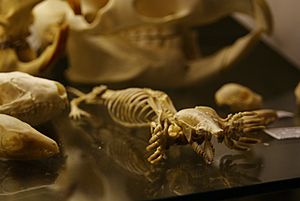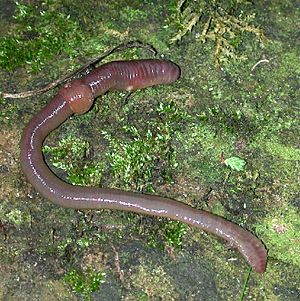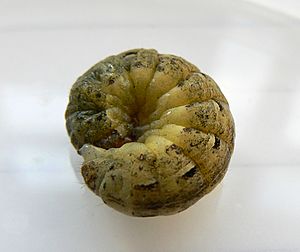Eastern mole facts for kids
Quick facts for kids Eastern mole |
|
|---|---|
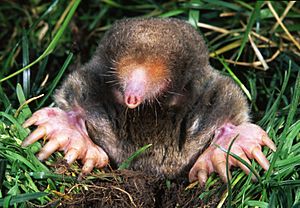 |
|
| Conservation status | |
| Scientific classification | |
| Genus: |
Scalopus
|
| Species: |
aquaticus
|
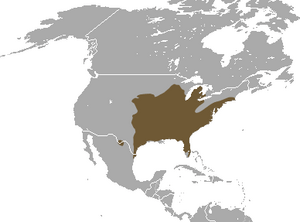 |
|
| Eastern mole range | |
| Synonyms | |
|
Sorex aquaticus Linnaeus, 1758 |
|
The eastern mole (Scalopus aquaticus) is a medium-sized, grey mole found in North America. It is the only type of mole in its group, called Scalopus. This mole has big, hairless, and flat front feet shaped like spades. These feet are perfect for digging!
Eastern moles live in Canada (Ontario), Mexico, and the eastern United States. They have the largest living area of any mole in North America. They like soft, rich soil found in thin woods, fields, and meadows. They dig tunnels both deep and shallow. You can often spot their tunnels by the piles of dirt they push up, called molehills.
Their nests are made of leaves and grass. Baby moles, usually two to five of them, are ready to live on their own in about four weeks. Eastern moles mostly eat earthworms and other small creatures living in the soil. But they also munch on some plants.
Animals like dogs, cats, foxes, and coyotes hunt eastern moles. Moles also have many tiny creatures called parasites living on or in them. Unlike gophers, moles do not eat plants, so they don't harm gardens in the same way. Sometimes they make bumps in lawns, but their digging helps the soil get air and eats harmful insects. Building golf courses has actually given moles more good places to live. These moles are common and not in danger of disappearing.
Contents
What Does the Eastern Mole Look Like?
The eastern mole is a small, strong animal that lives mostly underground. It is specially built for digging and living in tunnels. Its body is shaped like a cylinder, and it has a long head. A soft, movable snout sticks out over its mouth, with nostrils on top. This snout helps the mole feel its way around.
Its tiny eyes are hidden in its fur. They can only tell the difference between light and dark. The ear opening is small and covered by fur, but moles can hear quite well. They have a short, thick tail with a little fur. This tail helps the mole feel where it's going when it moves backward in its tunnels.
The mole's front feet are very large and wider than they are long. They have strong claws and an extra bone near the wrist that helps with digging. Moles usually hold their front feet straight up, with the palms facing out. Both the front and small back feet have special hairs that help the mole feel as it digs. The bones in their front legs and chest are very big. They give strong support to the muscles used for digging. The mole's hips are narrow, which lets it turn around in its tunnels by doing a partial somersault.
Eastern moles have soft, brownish-grey fur that looks like velvet. It might even look silver depending on how the light hits it. This fur lets them move backward easily in their tunnels. Male moles often have a brighter orange stripe on their belly. This comes from special skin glands. Sometimes, moles are born without color (albinos). They can look white, orange, or cinnamon-yellow, depending on their skin glands. Their face, feet, and tail are usually whitish to pink. Moles shed their fur in spring and fall. New fur grows first on their belly, then on their back, starting from the tail and moving forward.
You can tell if a mole is male or female by looking at the number of openings in its groin area. Females have three, while males have two. Moles also have a strong, musky smell from a gland on their belly. They leave this smell in their tunnels as they pass. This probably helps moles communicate with each other, especially during breeding season. It might also help keep predators away. Other scent glands are found near their rear end.
How Big Are Eastern Moles?
An eastern mole is about 16 centimeters (6 inches) long, including its 3 cm (1 inch) tail. It weighs about 75 grams (2.6 ounces). Males are usually bigger than females. The largest males are found in the northern Midwest of the United States. The smallest and darkest moles live near Miami, Florida.
Eastern moles have 36 teeth. They have 34 chromosomes in their cells.
Where Do Eastern Moles Live?
The eastern mole lives in Canada (Ontario), Mexico, and the United States. It has the widest range of any North American mole. In the U.S., you can find them from South Dakota and Wisconsin down to Florida and Louisiana. They also live west to Nebraska, Kansas, and central Texas. They are not found in the Appalachian Mountains, most of Canada, or northern New England.
Their living areas can be spread out. For example, some groups in Texas and Mexico are small and isolated.
Eastern moles like soil that drains well, like loose sand or loam. They avoid heavy clay, rocky, or very dry or wet soils. They are often found in pastures, open fields, meadows, and thin woods. Sometimes, human activities like building roads and golf courses create good homes for them. This is because these places often have better soil and enough moisture.
Eastern Mole Life and Behavior
Eastern moles are more common in warm places than in cold ones. In the southern United States, fields that are farmed often have many mole tunnels after a good rain. Eastern moles are active all day and night. They are most active around dawn and dusk. They usually stay active for about three hours at a time, but sometimes up to 6.5 hours.
Burrowing Habits
The eastern mole digs two main types of tunnels. Some are deep and permanent, used as safe places during hot, dry weather or when it's cold. These main tunnels can be 25 cm (10 inches) or more underground. The air in these tunnels can have low oxygen and high carbon dioxide. In winter, their shallow tunnels for finding food are dug deeper than those of some other moles.
When moles dig new tunnels, they push extra dirt up through vertical shafts. These piles of dirt are called "molehills." New tunnels just under the surface are marked by ridges and molehills. These shallow tunnels seem to help moles catch earthworms and other soil creatures after it rains. When digging, and probably at other times, the mole uses its nose to poke around and feel things. In soft soil, an eastern mole can dig about 6 meters (20 feet) in an hour!
The eastern mole's nest is made of leaves and grasses. It is usually a few inches to a foot or more below the surface. Nests are often found under a large rock, a tree stump, or a bush. They have several ways to get in, including one from below. However, moles in Florida are said not to build nests.
What Eastern Moles Eat
The eastern mole is a very hungry hunter. It eats food equal to 25% to 50% of its own weight every day! If kept as a pet, it would eat almost anything, even ground beef. In the wild, it mainly eats earthworms when they are available. But it also eats many other things. These include slugs, snails, centipedes, young and adult insects, scarab beetle grubs, and ants at all their life stages.
Mole Sounds
Eastern moles make high-pitched squeals, harsh, rough squeaks, and short snorting sounds. They also make noise by grinding their teeth.
Reproduction and Life Cycle
Female eastern moles are pregnant for about 45 days. They usually have one litter of two to five babies between mid-April and June. In warm places, babies might be born in March. The babies are born blind and without fur. They are quite large compared to their mother. After 10 days, they grow fine, soft, light-grey fur. They grow quickly and are ready to leave the nest and find food for themselves at about four weeks old.
How Moles Survive
Dogs, cats, foxes, and coyotes are some animals that hunt eastern moles. Moles also have many tiny creatures living on or in them called parasites. For example, a study of moles in Indiana found four types of fleas, one type of louse, one type of beetle, and at least 20 types of mites on them!
Names of the Eastern Mole

The famous scientist Carl Linnaeus first described the eastern mole. He found a dead mole in the water, which is why he named it aquaticus. This word means "found in water." It's a bit misleading because this mole is actually the least water-loving of all North American moles!
The first part of its scientific name, Scalopus, comes from two Greek words. Skalops means "mole" or "to dig," and pous means "foot." So, Scalopus refers to the mole's large front feet, which are used for digging.
The second word, aquaticus, is Latin for "found in water." Linnaeus gave it this name because its webbed feet made him think it lived in water, and the first mole he studied was found in water.
The common name "eastern mole" refers to where it lives, in the eastern part of North America. The word "mole" comes from an old English word, molle. This is related to another old word, mold-warpe, which means "earth-thrower."
Ancient Moles
Fossil remains of eastern moles have been found in the Upper Ohio Valley in Pennsylvania and West Virginia. They have also been found in ancient cave deposits in Texas.
Moles and Humans
Eastern moles help the soil by turning it over and making tunnels. These tunnels let air into the soil and help water soak deeper. Moles also eat harmful insects like cutworms and Japanese beetles.
Their fur is small and not good for making clothes, so it's not used by the fur industry. Sometimes, moles can be a nuisance when they make bumps in lawns, damage plant roots while looking for food, or eat sprouting corn. However, one person reported that moles completely got rid of Japanese beetles in their yard!
The eastern mole is listed as "Least Concern" by conservation groups. This means they are not worried about it disappearing. This is because it lives in a wide area, has a large population, lives in protected places, and can handle some changes to its home. It is not declining fast enough to be considered threatened.
See also
 In Spanish: Topo norteamericano para niños
In Spanish: Topo norteamericano para niños



